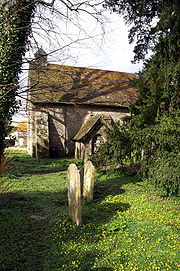
Corhampton
Encyclopedia
Corhampton is a village in Hampshire
, England
. It lies on the western bank of the River Meon
. It forms a civil parish
with Meonstoke
which adjoins on the eastern bank.
The village church was built around 1020 and is one of the few Saxon
churches in England that still functions. In its churchyard is an ancient yew with a 26ft girth
.

bowl barrow
s and 'Celtic' fields and circular earthworks probably dating from the Iron Age
have been found on Corhampton Down in the west of the parish.
Hampshire
Hampshire is a county on the southern coast of England in the United Kingdom. The county town of Hampshire is Winchester, a historic cathedral city that was once the capital of England. Hampshire is notable for housing the original birthplaces of the Royal Navy, British Army, and Royal Air Force...
, England
England
England is a country that is part of the United Kingdom. It shares land borders with Scotland to the north and Wales to the west; the Irish Sea is to the north west, the Celtic Sea to the south west, with the North Sea to the east and the English Channel to the south separating it from continental...
. It lies on the western bank of the River Meon
River Meon
The River Meon is a river that flows through an area of Hampshire in southern England known as the Meon Valley, it flows generally southwards from the South Downs to the Solent. For most of its route it is a chalk stream, with a length of 21 miles .The River Meon rises approximately...
. It forms a civil parish
Civil parish
In England, a civil parish is a territorial designation and, where they are found, the lowest tier of local government below districts and counties...
with Meonstoke
Meonstoke
Meonstoke is a village in Hampshire, England. Meonstoke lies in the Meon Valley where it cuts through the Middle Chalk of the South Downs. Old Winchester Hill is at the edge of the parish to the east....
which adjoins on the eastern bank.
The village church was built around 1020 and is one of the few Saxon
Anglo-Saxons
Anglo-Saxon is a term used by historians to designate the Germanic tribes who invaded and settled the south and east of Great Britain beginning in the early 5th century AD, and the period from their creation of the English nation to the Norman conquest. The Anglo-Saxon Era denotes the period of...
churches in England that still functions. In its churchyard is an ancient yew with a 26ft girth
Girth
In graph theory, the girth of a graph is the length of a shortest cycle contained in the graph. If the graph does not contain any cycles , its girth is defined to be infinity....
.

Archaeology
Bronze ageBronze Age
The Bronze Age is a period characterized by the use of copper and its alloy bronze as the chief hard materials in the manufacture of some implements and weapons. Chronologically, it stands between the Stone Age and Iron Age...
bowl barrow
Bowl barrow
Bowl Barrow is the name for a type of burial mound or tumulus. A barrow is a mound of earth used to cover a tomb. The bowl barrow gets its name from the fact that it looks like an upturned bowl...
s and 'Celtic' fields and circular earthworks probably dating from the Iron Age
Iron Age
The Iron Age is the archaeological period generally occurring after the Bronze Age, marked by the prevalent use of iron. The early period of the age is characterized by the widespread use of iron or steel. The adoption of such material coincided with other changes in society, including differing...
have been found on Corhampton Down in the west of the parish.

